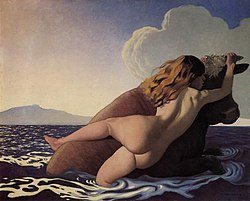Forfatter/Opretter:
Shortlink:
kilde:
størrelse:
1127 x 907 Pixel (188074 Bytes)
beskrivelse:
The painting Die Entführung der Europa (The Abduction of Europa, 1908) by Félix Vallotton (1865–1925) is one of the major works of this “great favourite” among the artists whose works were part of the former Hahnloser Collection. Hans R. Hahnloser, the son of the original collector couple, who since 1934 was professor in ordinary of art history at Bern University and a member of the Board of Trustees of the Kunstmuseum Bern, gave it to the Kunstmuseum in 1946 as a gift. According to the ancient myth, Zeus, appearing in the shape of a bull, abducted Europa, a beautiful princess, from the shores of today’s southern Lebanon, and swam with her on his back to Crete. A divine prophecy foretold that this part of the earth would be named after her. Since the turn of the century, Vallotton was increasingly fascinated by mythological subjects. However, he was less concerned about the legends and history than in ironical distance to the motifs and of relating a more universal content. The artist has represented the female figure, the bull, and the violet-coloured ocean in a stylized way and evokes a palpable impression of a break with all earthly things.[1]
Licens:
Public domain
Yderligere oplysninger om licens til billedet kan findes her. Sidste ændring: Wed, 26 Mar 2025 08:12:40 GMT
